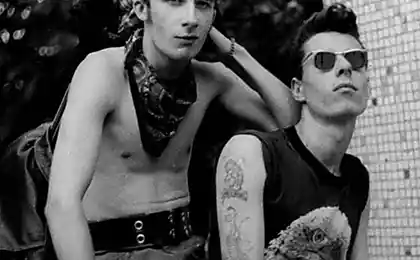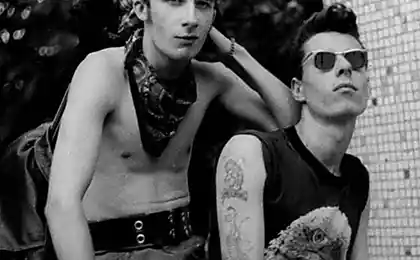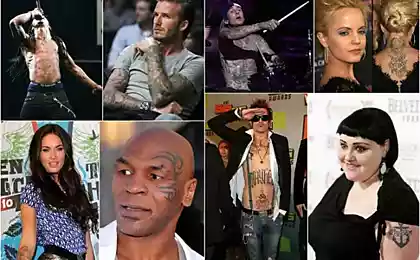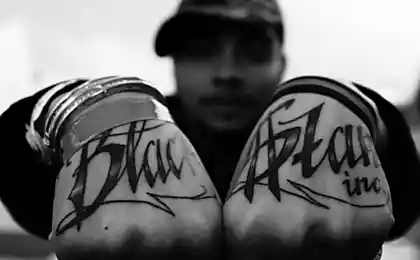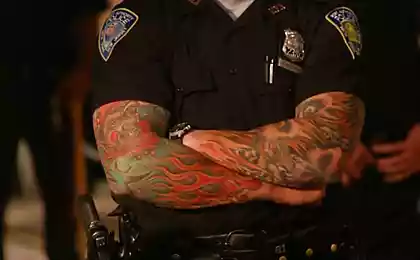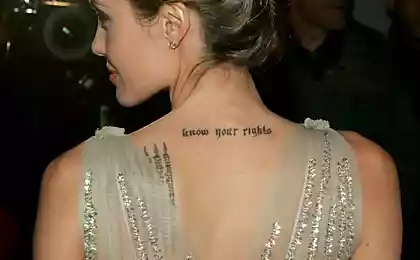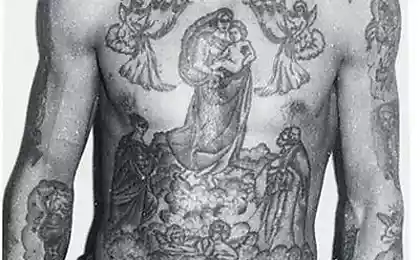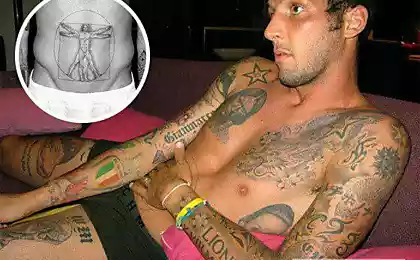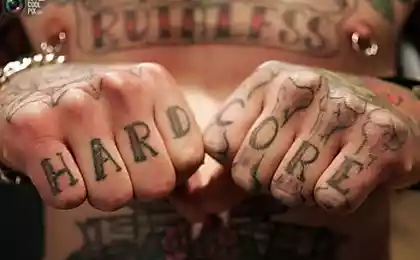2304
The history of tattoos in the Soviet Union
Many people have heard about the tattoo of the Soviet era just imagine prison tattoos that in fact is true. But do not forget that the tattoo was applied not only people from places not so remote, at different times they have done the sailors, soldiers, football fans, musicians and many others. Under the cut you will have to wait a very interesting style guide Soviet tattoos. Heavily tattooed people and could be exiled from the central areas of the city, a fresh tattoo in some military units could get reduced not the most pleasant ways to describe.
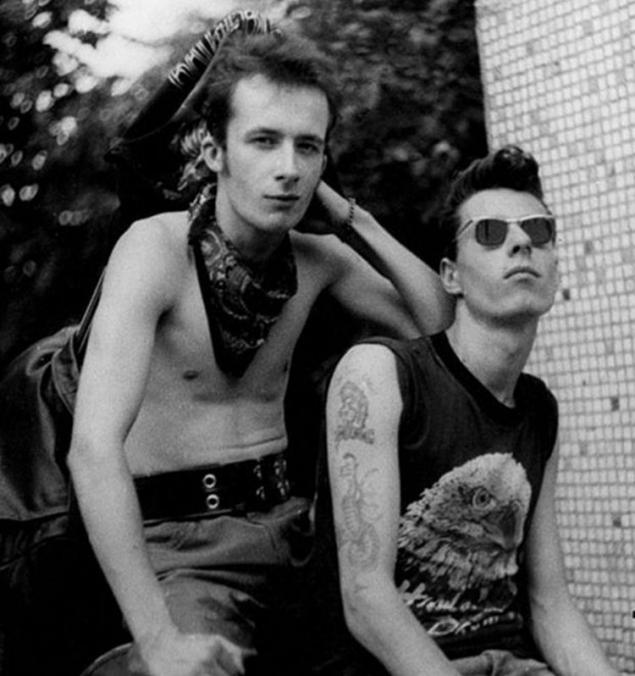
In Soviet tattoos were a variety of genres - but all of these genres had similar stylistic features. Soviet tattooing has become a conservative extension of the pan-European tradition of old school, which in the early 20th century, has not yet managed to make a breakthrough in artistry. Here it should be noted and primitive technique of Soviet works that were caused by the lack of the minimum equipment. The tattoo artist had to collect cars and a paint plant had improvised - clerical or carcasses burnt heel and urine, causing the tattoo had a maximum of three shades. Soviet tattoo most of their time (up to 80th) was developed as the internal and the external insulation - samples of successful Western and Soviet tattoos tattoos have seen very little.
History
In recent years, pre-revolutionary Russia was going through a renaissance tattoo - and so were several reasons. It should be noted that the same trend can be seen around the world - and perhaps only now tattoo has become as popular as in the beginning of the last century. On the popularity of tattoos in Russia in those years influenced intense relationship with Japan - there dragons brought on himself the whole of the aristocracy, even including Nicholas II and Grand Duke Mikhail Alexandrovich. As a bottom line, in 1905 appears the first written request to open a tattoo studio.
Tattoos are addicted not only to the upper ranks of the aristocracy - the end of the 19th century begins to form so-called "thieves 'community' with their own language patterns on the body. After the revolution, the two major categories of consumers tattoos are persecuted - but there is no documentary evidence of discrimination tattoos that time has been preserved. With that tattoos are condemned and contact with the criminal community during World War II and after, they are becoming increasingly popular: they are starting to make more and more people.

In the Khrushchev era tattoos begin to flicker in movies - there is a cult for domestic tattooists film George Danelia "Sergei." Tattooing is becoming popular in the village of yard-layers, but this popularity is not good for her - she is still strongly associated with the underworld. The situation does not change to 80, and the tattoo remains the lot of mostly prisoners, soldiers and sailors.
Tattoo subculture comes to only 80 - though the first rockers, beatniks and football fans begin to imagine something prick in the 70-ies. In the 80 th subculture begins to develop rapidly - there are first tattoo artists from the music environment, start the first experiments in this area. Tattoo captures everything a wider audience - there are first colored tattoos, more and more people are doing underground rock tattoos.
By the early 90's tattoo is booming, opened the first home studio, and in the spring of 1995 in Moscow club "Hermitage" is held the first tattoo convention, one of the participants is a tattoo artist Philip Lew dorisovyvaet face Maxim Chiriqui so that the latter falls in world calendar " Heavy tattooed man of the world ». At masters appear first machine and ink - although experiments in this area will continue for quite some time.
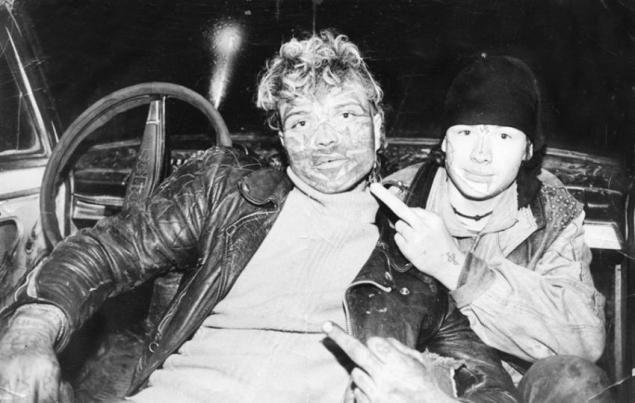
Army Tattoo
The heyday of the army or military military tattoo happened during the Second World War, and later this tattoo has become one of the most popular in the USSR. Nevertheless, we can not say that the tattoo was at least to some extent legalized. Tattoo on the service equated to the "mutilation" and non-commissioned officers had to keep track of such cases, and ideally avoid them. This was such a general rule - the more difficult were the conditions of service, the easier it belonged to tattoos: in dangerous conditions of service were other, more important reasons for concern.
Traditional figures in the military tattoo looks pretty simple and should be held primarily a functional role: to tell the owner where, when and how it is served. On the tattoos could see a group of blood (it was especially popular during the war in Afghanistan), the image of the armed forces, the years of service of the - or the symbols, emblems of troops or supplies to the military profession - ship, parasailing, jet flag. Each part has its own tradition of tattoos, though, the tradition did not prohibit digress like naked women.
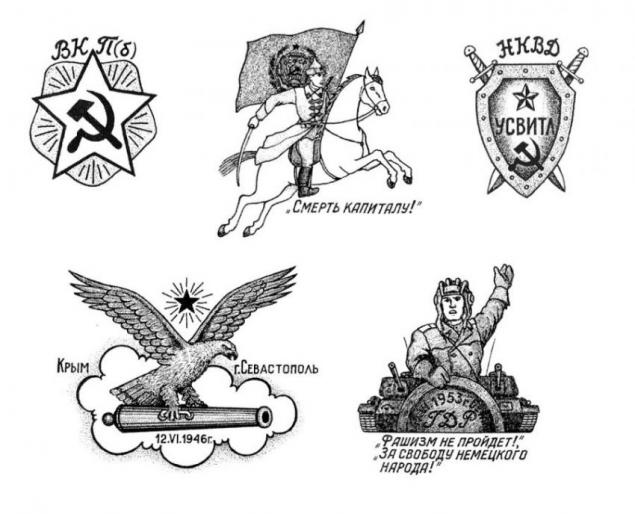
Tattoos sailors
Sailors in the USSR was exceptional and unspoken rules in the tattoo. First of all, it was, of course, simple and symbolic figures - anchors, sea gulls and the rest of attributes. That brought the sailors to get a tattoo from around the world - or tattoos, though resembling foreign. A classic example of marine tattoos will be the same film "Serge", where the captain on the beach removes his jacket, and on it a set of curves pictures - sea monster, a mermaid, Vechta sailors and bird with a crown and the words "Nura".
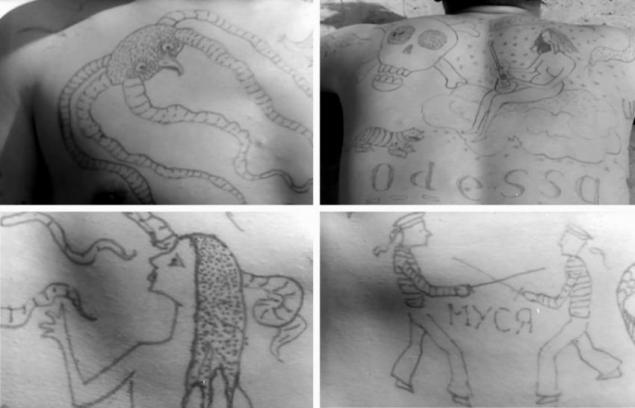
Prison
Details of the prison tattoos and their meanings, we have already written. The number of tattoos is simply amazing. According to the memoirs of World War II veteran and the veteran of the Russian Interior Ministry Arcadia Bronnikova, the USSR was about 25-30 million tattooed prisoners since 1960 and up to the 1990s.
In the Soviet prison tattoos have their own symbols to mark the sentences, the nature of the crime, even some personal traits. But because of a mass character, it becomes much more complicated and surprisingly detailed language with lots of signs. After the collapse of the Soviet Union saw the light a lot of prison officers, forensic archives - Bronnikov Boldaeva, Dubyagina who studied the tattoo prisoners for many years. The most famous archive - Danzig Boldaeva numbering 3,000 tattoos - edition published a three-volume Fuel in the Russian Criminal Tattoo.
"Russia has long lived in isolation, and as a result everything in it, from politics to art went kind of way, started to develop in its own way - says the publisher of the book Russian Criminal Tattoo Damon Murray. - Tattoos Russian underworld in this sense - a very typical example ».
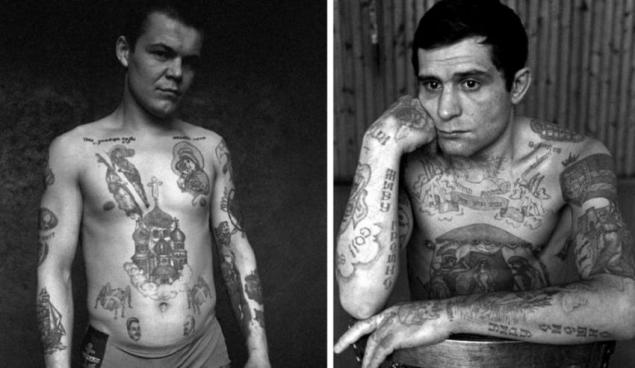
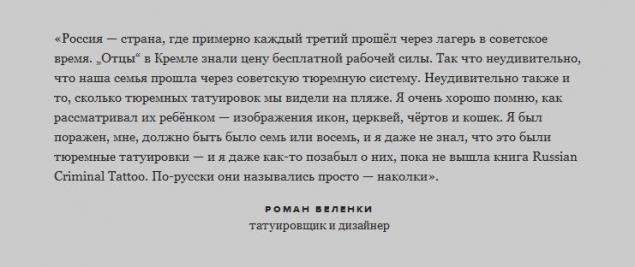
Yard tattoo
For those who wanted a tattoo but did not belong to the military or to the criminals had several options - try to learn how to stuff yourself or find someone who is doing nearby. Domestics tattoo for a long time will make the romantic characters and rebellious teenager. He recalls Michael Buster, "in the early '80s in the courtyard of some craftsmen for a glass of vermouth sailboat stabbed one acquaintance, a desperate fan of Iron Maiden and Motӧrhead - certainly not because of the enthusiasm of criminal romance».
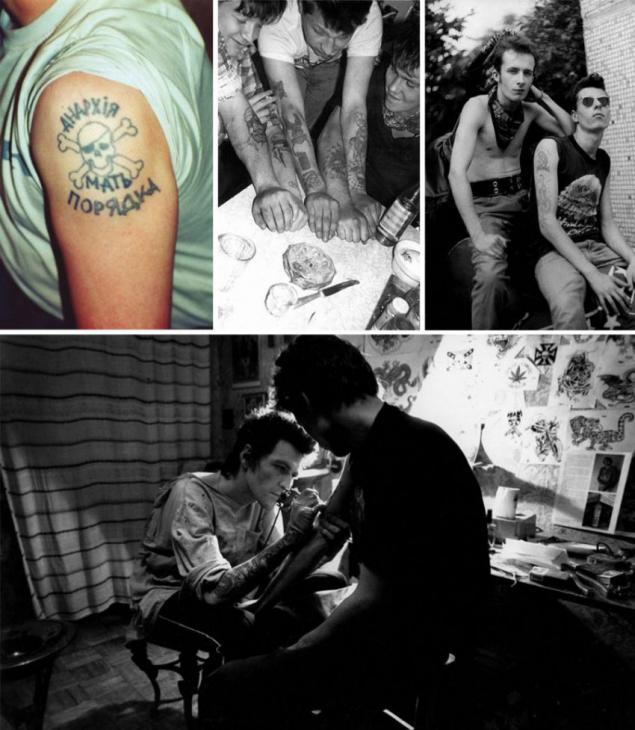
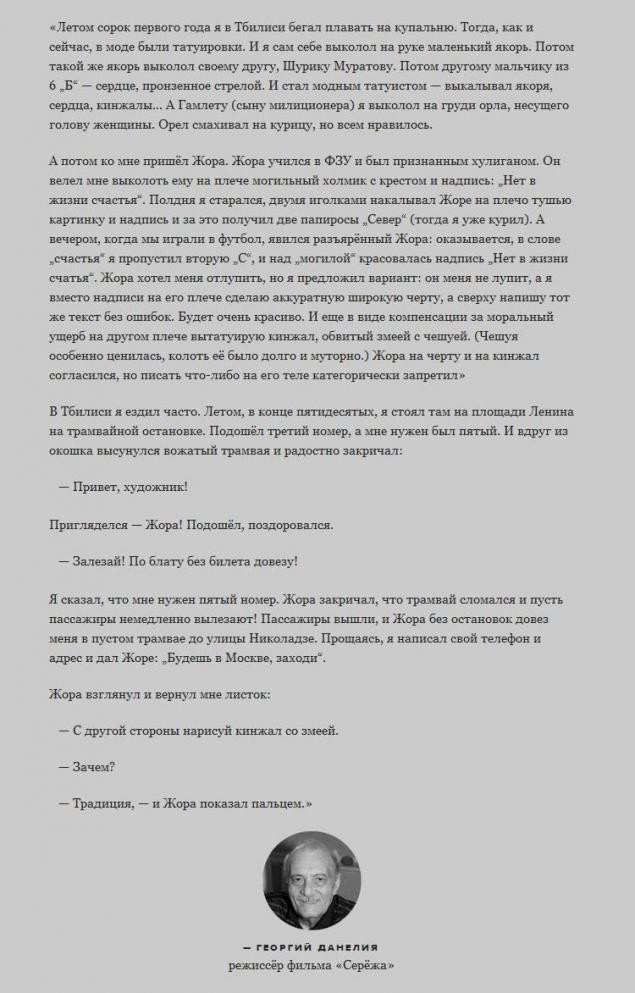
Subcultures
In the 1980s in the Soviet Union folded subculture with savoir-faire - bikers, punks and rockers, to a lesser degree, and this includes football fans. Tattooing has become an important marker of belonging to a sub-cultural environment - each group appears a tattoo artist, and each of the subcultures gradually develop his own style. For subcultural tattoos are important two points: First, they oppose - and sometimes even come into open conflict with prison tattoos. Secondly, subcultural tattoo invents color - and thus even more strongly opposes the prison tattoo.
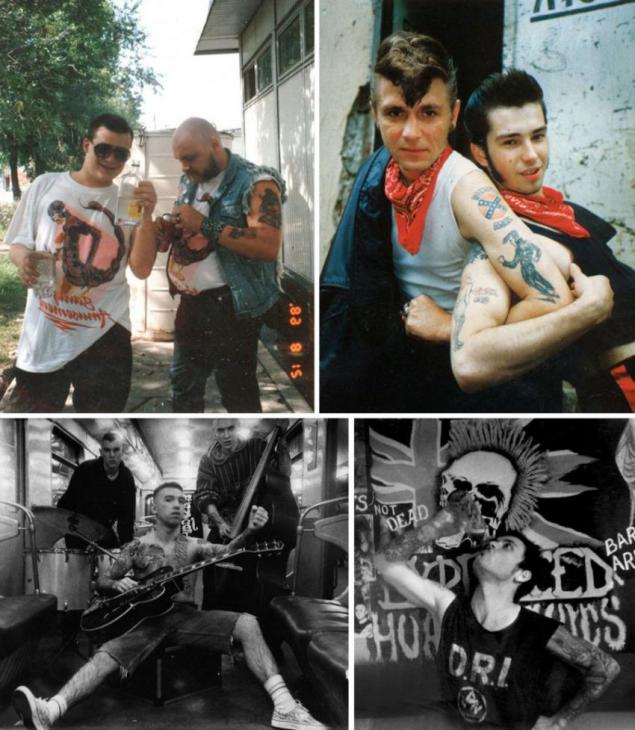
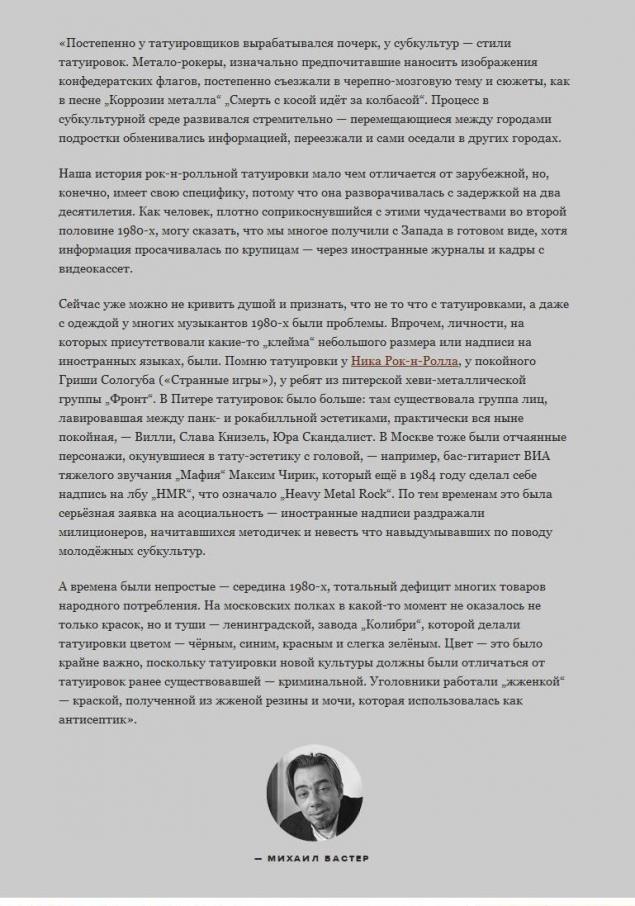

"At first, when I was a supporter of punk style, the whole get-together was limited to alcohol and music. A tattoo began with the magazine "Metal-Hammer." With pictures of the "Rose Tattoo". The magazine has this photo of a small, five by three centimeters, these guys are on it, all colored tattoos. I was the first time I saw this. The information did not exist then, and a magazine that miraculously fell into our hands. And then he was lost somewhere, but when it comes to tattoos, we are constantly remembered as an argument in discussions about tattoos. We argued that cool, but not cool, they said that they had seen in the pictures colored tattoos, but few believed us.
Upon returning to Sevastopol I started to draw her first sketches of tattooing. Then came the realization that it is necessary to modernize the tattooing machine. The first was made of razor guitar strings and buttons, all of this is attached to the plasticine. I felt that it's just not serious design. I planed from the type of wood butt such utter garbage, motor wrapped tape, bought "Children's World" ... Punk applied information design, that is, elements of style plus slogans. In this drawing, and was drawing up everything »


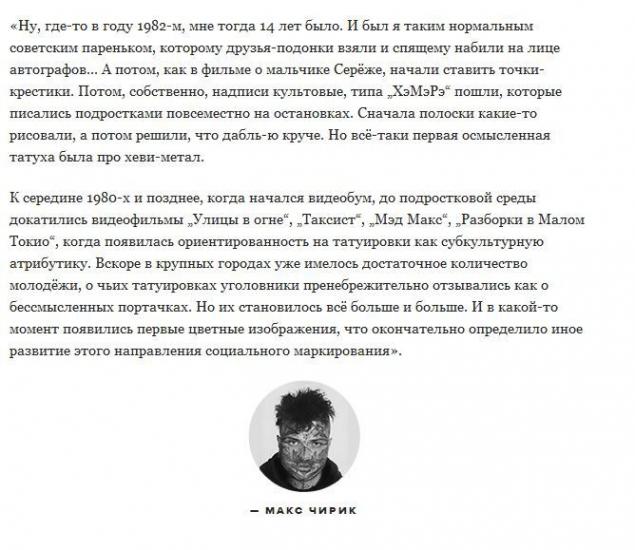

Results
Evaluate the results of the Soviet era is not easy - on the one hand, tattooing has come a long way on the other - it seems that it is marking time. In the Soviet Union there was a unique language of prison tattoos, which is admired by the world's best artists - but it is difficult to perceive a prison tattoo is anything like art.
Tattoo in the Soviet era, in principle, denied the right to apply to the arts - "portaki", "tattoos" and so forth are a lot of different purposes and meanings but one primary tattoo - decorating the body. And the roots of this phenomenon, probably deeper than mere persecution and prohibitions - a tattoo in its history developed as a clandestine art, and in one of our articles, we have listed only a few of these prohibitions.
The fact that the tattoo in Soviet times does not acquire its decoration and aesthetics, soon linked with the general system of Soviet values in which there is an philistinism contempt and condemnation of excessive concern about appearance - tsennnostey of the system, the results of which we are still trying to overcome. Changing this paradigm happens at the end of the Soviet era - and it is in this era, and there are first masters with their own handwriting, which will determine the tattoo in the early post-Soviet era.
Tattoo in the Soviet era is in total isolation and surprisingly there completely without tools and context, developing as a kind of a thing in itself. Anyone who has been tattooed, forced to invent their own America - to mix the dye mixture, collect cars of different models. Soviet tattoo goes under the heading of experimental - but it will remain so for many years of perestroika.

Source: www.furfur.me

In Soviet tattoos were a variety of genres - but all of these genres had similar stylistic features. Soviet tattooing has become a conservative extension of the pan-European tradition of old school, which in the early 20th century, has not yet managed to make a breakthrough in artistry. Here it should be noted and primitive technique of Soviet works that were caused by the lack of the minimum equipment. The tattoo artist had to collect cars and a paint plant had improvised - clerical or carcasses burnt heel and urine, causing the tattoo had a maximum of three shades. Soviet tattoo most of their time (up to 80th) was developed as the internal and the external insulation - samples of successful Western and Soviet tattoos tattoos have seen very little.
History
In recent years, pre-revolutionary Russia was going through a renaissance tattoo - and so were several reasons. It should be noted that the same trend can be seen around the world - and perhaps only now tattoo has become as popular as in the beginning of the last century. On the popularity of tattoos in Russia in those years influenced intense relationship with Japan - there dragons brought on himself the whole of the aristocracy, even including Nicholas II and Grand Duke Mikhail Alexandrovich. As a bottom line, in 1905 appears the first written request to open a tattoo studio.
Tattoos are addicted not only to the upper ranks of the aristocracy - the end of the 19th century begins to form so-called "thieves 'community' with their own language patterns on the body. After the revolution, the two major categories of consumers tattoos are persecuted - but there is no documentary evidence of discrimination tattoos that time has been preserved. With that tattoos are condemned and contact with the criminal community during World War II and after, they are becoming increasingly popular: they are starting to make more and more people.

In the Khrushchev era tattoos begin to flicker in movies - there is a cult for domestic tattooists film George Danelia "Sergei." Tattooing is becoming popular in the village of yard-layers, but this popularity is not good for her - she is still strongly associated with the underworld. The situation does not change to 80, and the tattoo remains the lot of mostly prisoners, soldiers and sailors.
Tattoo subculture comes to only 80 - though the first rockers, beatniks and football fans begin to imagine something prick in the 70-ies. In the 80 th subculture begins to develop rapidly - there are first tattoo artists from the music environment, start the first experiments in this area. Tattoo captures everything a wider audience - there are first colored tattoos, more and more people are doing underground rock tattoos.
By the early 90's tattoo is booming, opened the first home studio, and in the spring of 1995 in Moscow club "Hermitage" is held the first tattoo convention, one of the participants is a tattoo artist Philip Lew dorisovyvaet face Maxim Chiriqui so that the latter falls in world calendar " Heavy tattooed man of the world ». At masters appear first machine and ink - although experiments in this area will continue for quite some time.

Army Tattoo
The heyday of the army or military military tattoo happened during the Second World War, and later this tattoo has become one of the most popular in the USSR. Nevertheless, we can not say that the tattoo was at least to some extent legalized. Tattoo on the service equated to the "mutilation" and non-commissioned officers had to keep track of such cases, and ideally avoid them. This was such a general rule - the more difficult were the conditions of service, the easier it belonged to tattoos: in dangerous conditions of service were other, more important reasons for concern.
Traditional figures in the military tattoo looks pretty simple and should be held primarily a functional role: to tell the owner where, when and how it is served. On the tattoos could see a group of blood (it was especially popular during the war in Afghanistan), the image of the armed forces, the years of service of the - or the symbols, emblems of troops or supplies to the military profession - ship, parasailing, jet flag. Each part has its own tradition of tattoos, though, the tradition did not prohibit digress like naked women.

Tattoos sailors
Sailors in the USSR was exceptional and unspoken rules in the tattoo. First of all, it was, of course, simple and symbolic figures - anchors, sea gulls and the rest of attributes. That brought the sailors to get a tattoo from around the world - or tattoos, though resembling foreign. A classic example of marine tattoos will be the same film "Serge", where the captain on the beach removes his jacket, and on it a set of curves pictures - sea monster, a mermaid, Vechta sailors and bird with a crown and the words "Nura".

Prison
Details of the prison tattoos and their meanings, we have already written. The number of tattoos is simply amazing. According to the memoirs of World War II veteran and the veteran of the Russian Interior Ministry Arcadia Bronnikova, the USSR was about 25-30 million tattooed prisoners since 1960 and up to the 1990s.
In the Soviet prison tattoos have their own symbols to mark the sentences, the nature of the crime, even some personal traits. But because of a mass character, it becomes much more complicated and surprisingly detailed language with lots of signs. After the collapse of the Soviet Union saw the light a lot of prison officers, forensic archives - Bronnikov Boldaeva, Dubyagina who studied the tattoo prisoners for many years. The most famous archive - Danzig Boldaeva numbering 3,000 tattoos - edition published a three-volume Fuel in the Russian Criminal Tattoo.
"Russia has long lived in isolation, and as a result everything in it, from politics to art went kind of way, started to develop in its own way - says the publisher of the book Russian Criminal Tattoo Damon Murray. - Tattoos Russian underworld in this sense - a very typical example ».


Yard tattoo
For those who wanted a tattoo but did not belong to the military or to the criminals had several options - try to learn how to stuff yourself or find someone who is doing nearby. Domestics tattoo for a long time will make the romantic characters and rebellious teenager. He recalls Michael Buster, "in the early '80s in the courtyard of some craftsmen for a glass of vermouth sailboat stabbed one acquaintance, a desperate fan of Iron Maiden and Motӧrhead - certainly not because of the enthusiasm of criminal romance».


Subcultures
In the 1980s in the Soviet Union folded subculture with savoir-faire - bikers, punks and rockers, to a lesser degree, and this includes football fans. Tattooing has become an important marker of belonging to a sub-cultural environment - each group appears a tattoo artist, and each of the subcultures gradually develop his own style. For subcultural tattoos are important two points: First, they oppose - and sometimes even come into open conflict with prison tattoos. Secondly, subcultural tattoo invents color - and thus even more strongly opposes the prison tattoo.



"At first, when I was a supporter of punk style, the whole get-together was limited to alcohol and music. A tattoo began with the magazine "Metal-Hammer." With pictures of the "Rose Tattoo". The magazine has this photo of a small, five by three centimeters, these guys are on it, all colored tattoos. I was the first time I saw this. The information did not exist then, and a magazine that miraculously fell into our hands. And then he was lost somewhere, but when it comes to tattoos, we are constantly remembered as an argument in discussions about tattoos. We argued that cool, but not cool, they said that they had seen in the pictures colored tattoos, but few believed us.
Upon returning to Sevastopol I started to draw her first sketches of tattooing. Then came the realization that it is necessary to modernize the tattooing machine. The first was made of razor guitar strings and buttons, all of this is attached to the plasticine. I felt that it's just not serious design. I planed from the type of wood butt such utter garbage, motor wrapped tape, bought "Children's World" ... Punk applied information design, that is, elements of style plus slogans. In this drawing, and was drawing up everything »




Results
Evaluate the results of the Soviet era is not easy - on the one hand, tattooing has come a long way on the other - it seems that it is marking time. In the Soviet Union there was a unique language of prison tattoos, which is admired by the world's best artists - but it is difficult to perceive a prison tattoo is anything like art.
Tattoo in the Soviet era, in principle, denied the right to apply to the arts - "portaki", "tattoos" and so forth are a lot of different purposes and meanings but one primary tattoo - decorating the body. And the roots of this phenomenon, probably deeper than mere persecution and prohibitions - a tattoo in its history developed as a clandestine art, and in one of our articles, we have listed only a few of these prohibitions.
The fact that the tattoo in Soviet times does not acquire its decoration and aesthetics, soon linked with the general system of Soviet values in which there is an philistinism contempt and condemnation of excessive concern about appearance - tsennnostey of the system, the results of which we are still trying to overcome. Changing this paradigm happens at the end of the Soviet era - and it is in this era, and there are first masters with their own handwriting, which will determine the tattoo in the early post-Soviet era.
Tattoo in the Soviet era is in total isolation and surprisingly there completely without tools and context, developing as a kind of a thing in itself. Anyone who has been tattooed, forced to invent their own America - to mix the dye mixture, collect cars of different models. Soviet tattoo goes under the heading of experimental - but it will remain so for many years of perestroika.

Source: www.furfur.me
